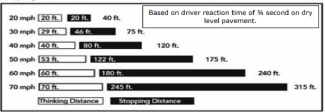Stopping Your Vehicle
Even when road and vehicle conditions are ideal and the driver is perfectly alert, it takes a great distance to stop a motor vehicle. To stop your vehicle, three (3) things must happen:
- You must perceive (recognize) the danger and the need to stop.
- Your brain must react to the hazard and tell your foot to step on the brake.
- Your foot must move to the brake pedal and operate the brake (braking).
The distance your vehicle travels between the time you recognize the danger and react to it is called your perception distance. The distance your vehicle travels when you move to step on the brake is called your reaction distance. After seeing danger, it takes the average driver about ¾ of a second to apply the brake. The higher the driving speed, the further your vehicle will travel before you are able to apply the brake. The distance your vehicle travels from the time the brakes are applied to the time that the vehicle is brought to a stop is called braking distance. Braking distance will vary depending on the conditions of the road and level of traction. It is important to realize that on wet or icy roads the braking distance will be much longer because of reduced traction. Therefore, when driving in these conditions, you must drive slower. Oil, rubber, dirt, and water combine to make roads especially slippery when it first starts to rain.
The perception distance plus the reaction distance plus the braking distance equals the total stopping distance.

In addition, two (2) situations may occur which can prevent you from stopping when you need to:
Velocitizing occurs when you begin to feel that you are going slower than your actual speed. You can avoid this by varying your speed slightly when driving long distances on the highway. Use care while reducing your speed as you enter exit ramps.
Hydroplaning occurs when the front tires of your vehicle lose contact with the road surface on a wet road, and you lose steering capability. Guard against hydroplaning by keeping tire pressure inflated to manufacturer’s recommended standard, reducing speed, and being careful while driving in the rain. Avoid areas with standing water and where water pools.